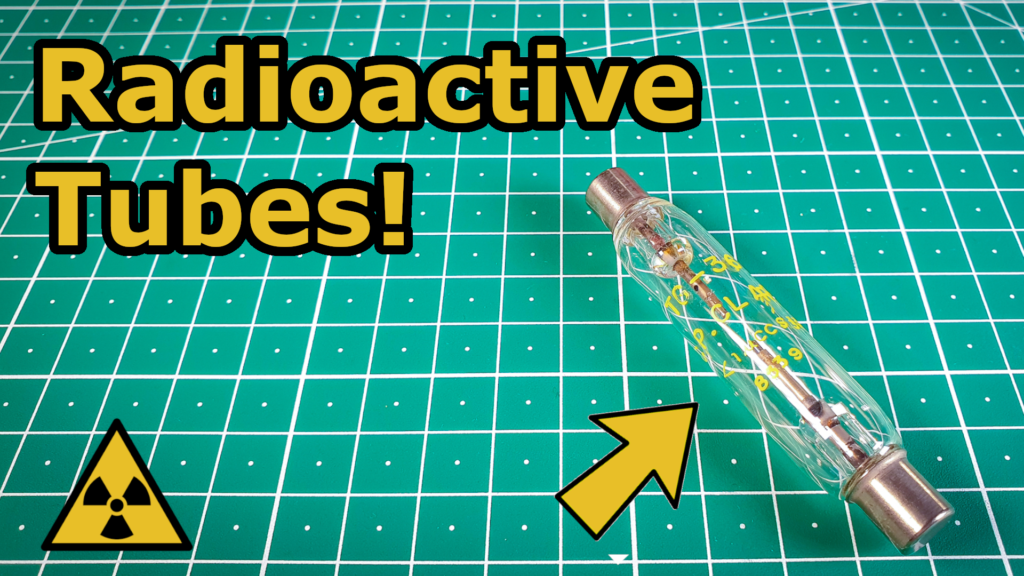Introduction
Small amounts of radioactive isotopes are often used in common household items. A good example of that would be 241Am in smoke alarms or 226Ra in watches but today, I want to focus on tubes (valves) and other less common electrical components containing radioactive isotopes!

TG-36 Spark Gap Tube
Isotope: 137Cs
Activity originally: <1 uCi
TG-36 is a spark gap tube most probably produced in the late 1960s or early 1970s and it originally contained around 1 uCi (37 kBq) of 137Cs. Even though some 137Cs has decayed, it is still active enough so that it can be used as a calibration source for gamma spectroscopy as well as a check source for Geiger counters. When placed right against my RAYSID gamma spectrometer with a CsI(Tl) 5cm3 crystal, the activity increased by 218 CPS.


Bomac 1B63A Waveguide Tube
Isotope: 60Co
Activity (originally): <1 uCi
1B63A tube contains a small amount of 60Co which was used to better ionise the gas inside of the tube. Originally these tubes contained 1 uCi of Cobalt-60, however, Cobalt-60 has a rather short half-life of only 5.3 years, which means that there is less than 0.013 uCi left which means that there is no detectable activity. A gamma spectrum of Cobalt-60 should show two characteristic peaks at 1173 keV and 1332 keV.

DV3A Voltage Regulator Tube
Isotope: 63Ni
Activity: not detectable
Victoreen’s DV3A is a voltage regulator tube containing a microscopic amount of 63Ni. These tubes can be found in some old US survey meters from the cold war. I found mine in my Eberline 120 survey meter that I have bought some time ago without even knowing the tube contained any radioactive isotopes! Unfortunately, 63Ni emits only weak beta radiation which is not able to go through the glass tube and even if it would, the amount of 63Ni is too small to be detected.

2x2a Rectifier Tube
Isotope: None
Activity: None
While this tube does not contain any radioactive isotopes it can generate x-rays if hooked to a high voltage. Sadly, I don’t own a power supply capable of generating high voltage so I won’t be able to demonstrate it. Maybe one day…

AZS Switch
Isotope: 226Ra
Activity: 17.1k CPM (STS-5)
AZS switches were often used in different vehicles such as tanks and military planes produced in the Warsaw pact. The tip of the switch has radium 226 paint on it in order to make it glow in the dark but it also causes it to be very radioactive and emit huge amounts of radon since most of these switches are not sealed as a result of their age. It is worth mentioning that newer AZS have a non-radioactive, glow in the dark paint. An easy way to check if the switch contains 226Ra is simply to check if it glows in the dark. If NOT, then it is most probably radium.

BH-45M
Isotope: 226Ra
Activity: 200k CPM (LND 7311)
BH-45M is very similar to the above mentioned AZS with the main difference being a slightly smaller activity.
Wait, there is more!
If you know of any interesting tubes, switches and other electrical components containing radioactive isotopes, let me know in the comments section and I’ll do my best to get them and add them to the post!

The 1B22 Spark Gap Tube uses radium-226, I believe. It was used as a pulse switch for radar.
Hi Radium1950,
Yes, you are correct! I’m still expanding my collection and once I get any new additions I will update the post.
Thanks for writing and stay active!
Hi, magnetrons from microwaves contain a little bit of Thorium
Thanks for sharing! I’ll have a look at them when I get a chance 🙂
I found an article containing the names of four radioactive Electronic tubes
link https://physicsopenlab.org/2016/06/03/radioactive-electron-tubes/
The WESTERN ELECTRIC 346B ELECTRON TUBE also has Ra226.